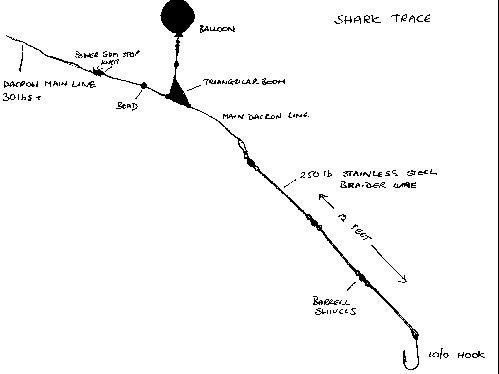|
Home
Catch
reports
Contact
 B
& B B
& B
 Fishing Fishing
 Terms Terms
|
SHARK FISHING ABOARD BLUE
WATER
BEST TIMES: The Blue Shark is one
of our biggest and most exciting summer visitors. They can
be expected from mid June through to the end of September
but they are sensitive to the water temperature so the
length of time they are with us varies according to the
weather we get during the year. If you want to be sure of
being here during the most likely time it is normally from
mid July to end of September.
-
TACKLE AND TECHNIQUES: The tried
and tested method of Shark fishing is the best and it
centres around a delightful substance called RUBBY DUBBY.
The base of this is Mackerel ground up until it looks
like a porridge. A lot of skippers would add all kinds of
secret ingredients to it but Johns preference is for day
old Mackerel, nothing added, just loads of it. Once you
have this made, and its not a job for the faint hearted,
the boat is allowed to drift with the rubby dubby dipping
in and out of the water so as it leaves a good trail of
yummie smells for the Shark to follow. The bait is a
Mackerel flapper suspended a short distance from the boat
in the middle of this trail and from then on it's a
waiting game.
TACKLE: The best tackle is good a quality rod and reel in
the 30lbs class. The line should be either 30lbs Mono or
Dacron and MUST be in good condition. The new superbraids
are not suitable unless they are very heavy, ie 80lbs or
more. The end tackle is also very important as the sharks
teeth are incredibly sharp. The trace LINK TO SHARK TRACE
DRAWING should be 12 feet (3.5 meters) long and made of
braided stainless steel wire, NOT PVC COATED WIRE. It should
have 3 swivels at regular intervals attached with crimp and
offshore knot, a 10/0 bronze O'Shaugnessy or similar
provides the business end. As the bait is suspended at about
40 feet from the surface a balloon is used for a float. It
is attached to the main line by means of a small plastic
boom and power gum stop knot and this has the advantage of
releasing the balloon when a fish strikes. Floats that are
solid or are tied to the line are not good as they give a
lot of drag when fighting a fish. An alternative method to
traditional bait fishing is fly fishing for Blue Shark. Rudy
Van Duijnhoven got the first European fly caught Blue in
1997 aboard Bluewater. Its really exciting form of fishing
as you must attract the fish right to the boat so as you can
see your quarry. The specialist tackle required is on board
if you would like to try.
-
YOUR CHANCES AND HOW BIG ARE THEY: Their size varies
quite a bit but they average around 55lbs or 25kgs. A
small one will be in the region of 20 lbs and the
Bluewater record stands at 150lbs. They can be plentiful
and Bluewaters best day was 34, but this was exceptional.
On an average day we should catch from 4 to 6 fish and we
may well have seen a couple of others. WEATHER: The
weather makes a big difference to Shark fishing, too much
wind and the boat will drift too fast leaving a broken
trail for the Sharks to try and follow, not enough wind
and the boat wont move fast enough to spread out a good
trail.
TAG AND RELEASE: All the fish
caught aboard Bluewater are tagged and released, so we use
hooks that corrode quickly and John is an expert at
unhooking the fish causing them as little damage as
possible. The tagging programme is run by the Irish Central
Fisheries Board and it is the largest marine sportfish
tagging programme in Europe. The Blue Shark is truly nomadic
and some of Bluewaters catches have been recaptured as far
away as the Grand Banks and the Cape Verde
Islands.

|
